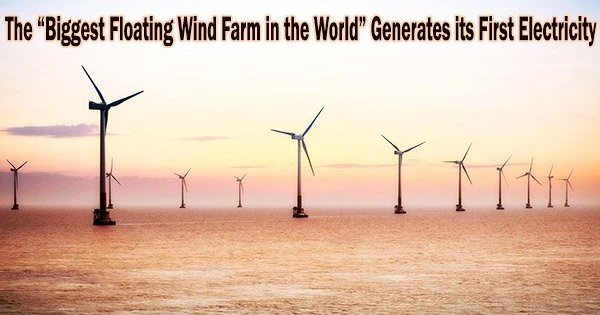Over the weekend, a facility dubbed the largest floating wind farm in the world generated its first power, and more turbines are expected to start operating before the year is through.
The first wind turbine at Hywind Tampen began producing electricity on Sunday afternoon, according to a statement released on Monday (November 14, 2022) by the Norwegian energy company Equinor, which is better renowned for its work in the oil and gas sector.
Hywind Tampen will be utilized to help power operations at oil and gas sites in the North Sea, despite the fact that wind is a renewable energy source. Equinor said Hywind Tampen’s first power was sent to the Gullfaks oil and gas field.
“I am proud that we have now started production at Hywind Tampen, Norway’s first and the world’s largest floating wind farm,” Geir Tungesvik, Equinor’s executive vice president for projects, drilling and procurement, said.
“This is a unique project, the first wind farm in the world powering producing oil and gas installations.”
Between 260 and 300 meters deep, Hywind Tampen is situated around 140 kilometers (86.9 miles) off the coast of Norway.
The wind farm’s first seven turbines are expected to start operating in 2022, followed by the installation of the final four in 2023. According to Equinor, the system’s ultimate capacity will be 88 megawatts.
Alongside Equinor, the other companies involved in the project are Vår Energi, INPEX Idemitsu, Petoro, Wintershall Dea and OMV.
According to Equinor, Hywind Tampen is anticipated to supply about 35% of the electricity needed by the Gullfaks and Snorre fields. “This will cut CO2 emissions from the fields by about 200,000 tonnes per year,” the company added.
However, there may be some opposition to using a floating wind farm to support the production of fossil fuels.
Fossil fuels’ effect on the environment is considerable and the United Nations says that, since the 19th century, “human activities have been the main driver of climate change, primarily due to burning fossil fuels like coal, oil and gas.”
Speaking at the COP27 climate change summit in Sharm el-Sheikh, Egypt, last week, the U.N. Secretary General issued a stark warning to attendees.
“We are in the fight of our lives, and we are losing,” Antonio Guterres said. “Greenhouse gas emissions keep growing, global temperatures keep rising, and our planet is fast approaching tipping points that will make climate chaos irreversible.”
An emerging industry
Equinor said the turbines at Hywind Tampen were installed on a floating concrete structure, with a joint mooring system. One advantage of floating turbines is that they can be installed in deeper waters than fixed-bottom ones.
Back in 2017, Equinor started operations at Hywind Scotland, a five-turbine, 30 MW facility it calls the world’s first floating wind farm.
Since then, a number of major companies have made moves in the sector.
In Aug. 2021, RWE Renewables and Kansai Electric Power signed an agreement to assess the feasibility of a “large-scale floating offshore wind project” in waters off Japan’s coast.
In Sept. of that year, Norwegian company Statkraft announced a long-term purchasing agreement relating to a 50 MW floating wind farm which it has also dubbed the “world’s largest” off the coast of Aberdeen, Scotland.
And a few months later, in December 2021, plans for three significant offshore wind facilities in Australia were revealed, two of which aim to use floating wind technology.
Earlier this year, meanwhile, the White House said it was targeting 15 gigawatts of floating offshore wind capacity by the year 2035.
“The Biden-Harris Administration is launching coordinated actions to develop new floating offshore wind platforms, an emerging clean energy technology that will help the United States lead on offshore wind,” a statement, which was also published by U.S. Department of the Interior, said at the time.
As well as the 15 GW ambition, a “Floating Offshore Wind Shot” aims to reduce the costs of floating technologies by over 70% by the year 2035.
“Bringing floating offshore wind technology to scale will unlock new opportunities for offshore wind power off the coasts of California and Oregon, in the Gulf of Maine, and beyond,” the statement added.
















